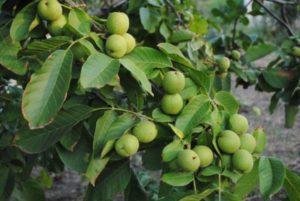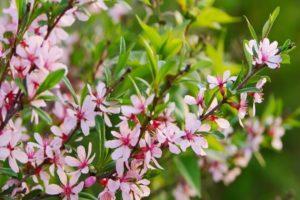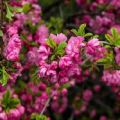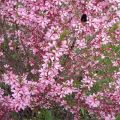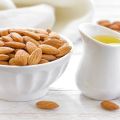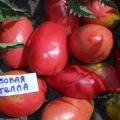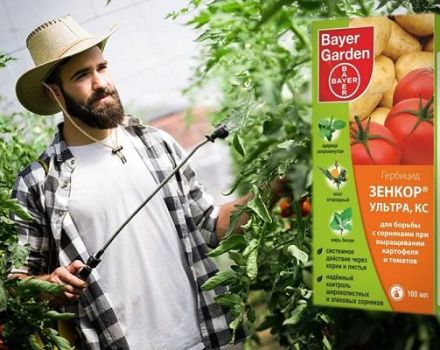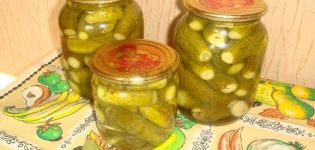Description of the almond variety Pink foam, planting and care rules in the open field
Almonds, which bloom in early spring, are a wonderful decoration for the garden. The Pink Foam almond variety is one of the beautiful shrubs used by landscape designers and gardeners to decorate the territory. For double pink flowers, similar to small roses, it is sometimes called the steppe sakura.
General Information About Almonds Pink Foam
Almond Pink foam (also called Luiseania) is a low-growing tree or shrub up to 2 meters high. Pink palette double flowers bloom in early spring. They densely stick to the branches, attract bees, which collect pollen from fragrant inflorescences. The fruit of an almond is a drupe framed by a velvety pericarp.
Pink foam begins to bear fruit 4-5 years after planting. One tree can produce 6-12 kilograms of useful nucleoli. Almonds easily tolerate severe frosts (up to -45 ° C), with good care they grow in one place for up to 100 years. He has a branched root system, which helps to strengthen the soil on the slopes.
Note! All varieties of almonds are self-fertile, so you need to plant a pollinator on them..
Advantages and disadvantages of the variety
The Pink Foam shrub has the following positive qualities:
- attracts bees;
- its fruits are a storehouse of vitamins;
- great frost resistance;
- unpretentious in care;
- has a decorative appearance;
- protects slopes and ravines from spreading.
Disadvantages include shading intolerance, susceptibility to disease when grown in areas with damp winters. In addition, when cultivating the variety in the northern regions, the fruits may not have time to ripen.
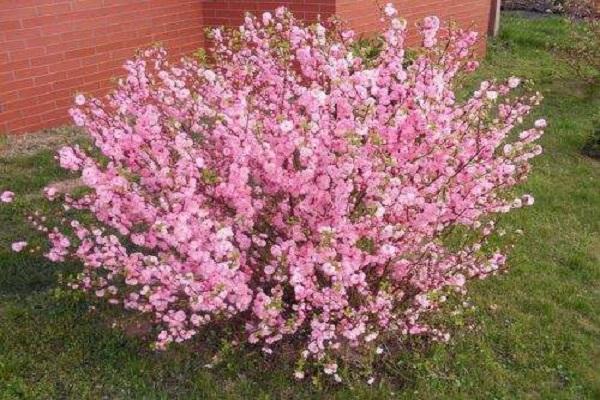
Features of growing a plant
The further growth of the plant will depend on how correctly the time and place of planting, as well as the planting material itself, will be chosen. Correct planting and caring for almonds Pink foam is the key to the decorativeness of the planting.
Time and place
Young plants can be planted in open ground twice a year: in spring, after the establishment of warm weather, and in autumn, when leaf fall ends. The seedlings will tolerate autumn planting easier. The planting site should be brightly illuminated by the sun for almost the entire day: shading by neighboring trees is permissible for no more than 3 hours.
The soil in which the almonds are planted should be light, permeable to water and air. In heavy soil, the plant will quickly die.The best option: sandy loam or loamy soil, fertilized with nutrients. In the area where the almonds will be planted, groundwater should not be close to the soil surface.
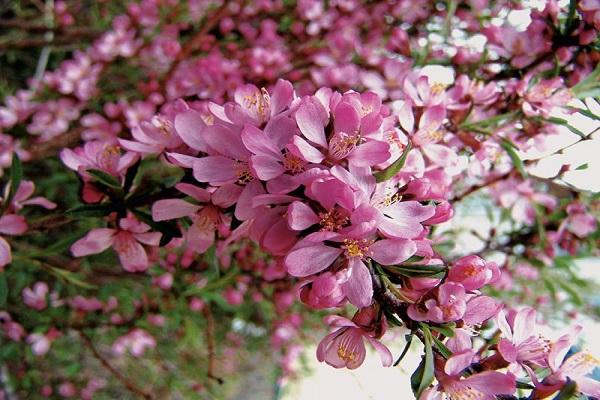
The choice of planting material
When choosing a seedling, you need to pay more attention not to the height, but to its root system. The less it is damaged, the faster it adapts and the better the plantation will grow. In addition, small sucking roots should be present on the root of the plant being purchased. It is they who serve as the main supplier of water to the ground part of the plantation.
The roots of the almonds sold should be damp: wrapped in a wet cloth or placed in a bucket of water or wet sand. Do not buy a plant with spots on the bark - this is a sign of a disease. It is also not recommended to buy a seedling if gum is flowing on it: it is probably affected by pests or disease.
Advice! It is necessary to purchase seedlings in nurseries or from trusted sellers.
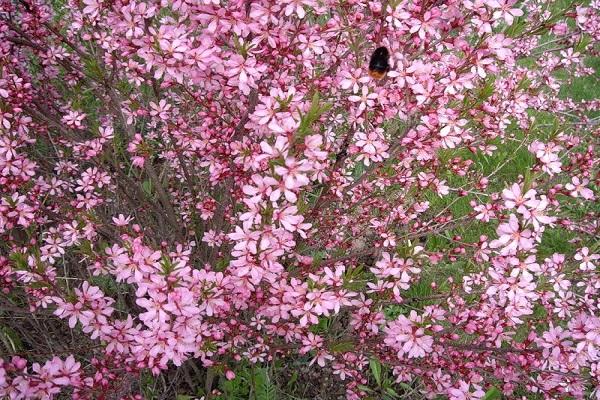
Planting process
Almond planting technology step by step:
- A hole is dug 50 centimeters deep.
- At its bottom, drainage is laid, consisting of expanded clay, fine gravel, sand.
- Then a layer of substrate is poured, the roots are gently straightened on it.
- Fertile soil is poured so that the root collar is 10 centimeters below ground level.
- The root circle is watered with water, then mulched with peat or rotted manure.
In order for young plants to grow evenly, not to bend from the wind, you need to install small supports of metal or wood next to them.
Care advice
To maintain a decorative appearance, Pink Foam almonds must be looked after: fed, watered in time, and pruned.

Fertilizing the soil
Almonds are fed several times during the season. The first top dressing will be mulch from rotted manure. It will not only retain moisture, but will also provide food to the roots when watering. After 2-3 weeks, the bush is spilled with fertilizer of the following composition:
- 10 grams of urea;
- 20 grams of ammonium nitrate;
- 10 liters of warm water.
In autumn, almonds are fed with a dry mixture consisting of the following components:
- 20 grams of double superphosphate;
- 20 grams of potassium sulfate.
This mixture is sufficient to fertilize an area of 1 m².
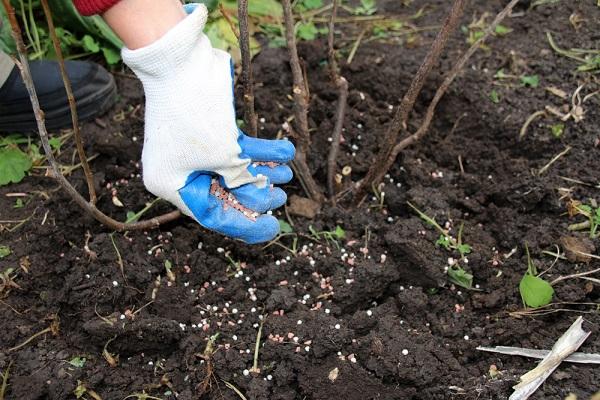
Watering rules
Almonds Pink foam watered as needed. On sandy soils, for example, this is done more often because the water evaporates quickly from them. A heavier substrate is less hydrated. A deficiency and an excess of moisture are equally harmful to a plant. One almond bush consumes 7-10 liters of water.
Pruning
The first pruning in the current season is done in the spring, before the sap flow begins. At the same time, damaged, broken, dry branches are removed. In addition, if the shoots are competing, thicken each other, then a strong, healthy branch is selected, and the other is cut out. When the Pink Foam has faded, they begin formative pruning: not only will it not hurt, but vice versa, it will contribute to better flowering in the next season.
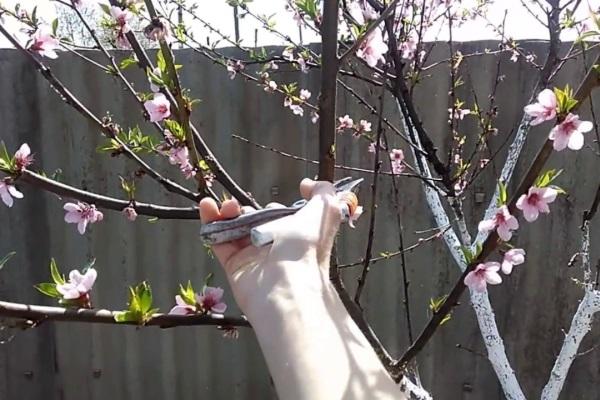
Plant protection from diseases and pests
In order to prevent diseases of almonds, it is necessary to properly care for it: remove diseased branches, prevent thickening of the crown, remove foliage and weeds from the root circle, and do not overmoisten the soil. When a plant is damaged by diseases, it is sprayed with Bordeaux liquid, antifungal drugs.
When pests are infested, various insecticides are used. If the almonds did not have time to undergo too much attack by harmful insects, alternative methods of treatment can be used against them: infusion of tobacco, potato tops, a solution of laundry soap.To prevent the appearance of the bark beetle, the trunks of the almonds are whitewashed with lime.
Important! When using chemicals, it is necessary to protect hands with gloves, respiratory tract with a respirator or gauze bandage, eyes with glasses.
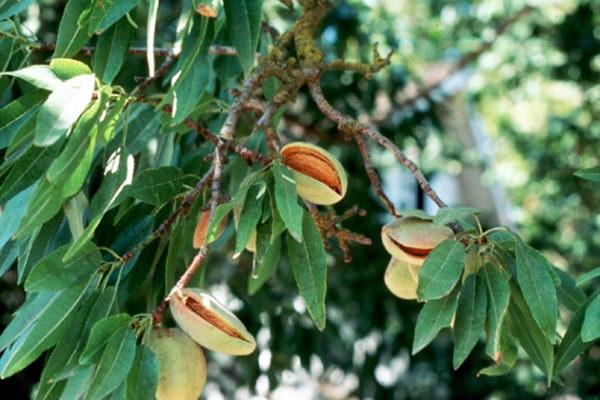
Reproduction of pink almonds
There are several ways to dilute pink foam almonds: budding, seeds, layering.
Budding
You can plant Pink foam on plums, cherry plums, bird cherry, and other varieties of almonds. The procedure is performed in April or August when the weather is cool. Vaccination is performed as follows:
- Dust and dirt are removed from the stock with a rag.
- At a distance of 10 centimeters from the root collar, a T-shaped incision is made on the trunk with a knife.
- The incised bark is retracted to the side.
- A small strip of bark with bud and wood is cut from the Pink Foam.
- The shield is inserted into a previously prepared incision. It should fit completely into the slot.
- The edges of the bark are pressed, which are then wrapped with adhesive tape, electrical tape or plaster in 3-4 circles.
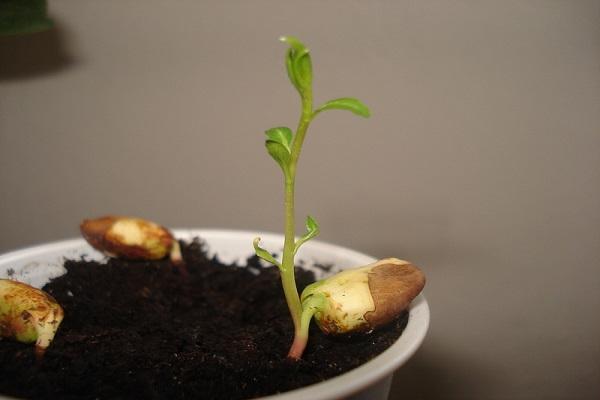
It is necessary to pay attention to the fact that the kidney should not be closed. With spring grafting, the tape is slightly weakened after 2 weeks, after the appearance of foliage, it is removed. In autumn budding, the dressing is left on the plant until spring. All shoots appearing on the rootstock are removed
Additional Information. Almonds are used as a rootstock for peaches and apricots, which are more sensitive to weather conditions.
Seeds
To propagate the plant with seeds, they are purchased from a flower shop or kernels from mature almond trees are used. When planting in spring, seeds require stratification (keeping them at low temperatures) for 3 months. A refrigerator can be used for this procedure. In the fall, the seeds are planted in open ground immediately after harvesting.
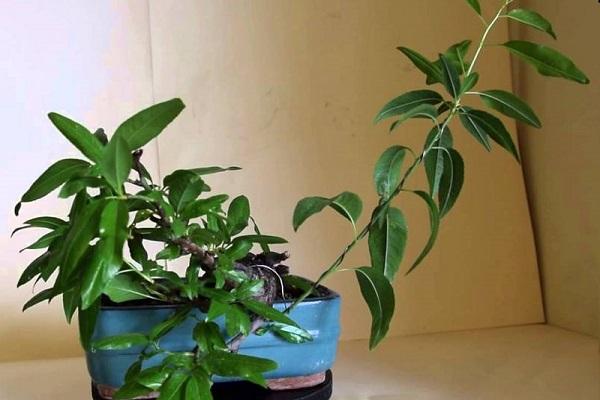
Layers
Reproduction by layering is done as follows:
- the lower branches are bent to the ground, fixed with a wire twisted in an arc;
- from above, the attachment points are sprinkled with earth, watered;
- after 1 year, the rooted cut is dug up, transplanted to a new place.
Throughout the year, it is necessary to constantly water, loosen, weed the rooting site of the cuttings.
Almond Pink foam is used as a wonderful decoration of the local area. It is decorative, unpretentious in maintenance, frost-resistant, for which we love landscape designers and gardeners. Following the recommendations for growing almonds, every summer resident and gardener will be able to grow it on their site without much difficulty.
